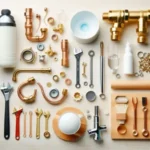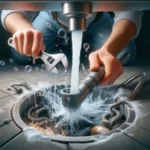A broken door handle may seem like a minor inconvenience, but it can quickly become a frustrating obstacle in your daily routine.
Whether it’s a stubborn handle that won’t turn, a loose knob that jiggles unnervingly, or a completely detached mechanism, dealing with a malfunctioning door handle can disrupt the flow of your home. Thankfully, you don’t need to call in a professional or invest in costly replacements to restore functionality. With just a few common tools and a little bit of know-how, you can tackle this DIY project and have your door handle working like new in no time. In this guide, we’ll walk you through five easy steps that will not only empower you to fix your door handle efficiently but also enhance your overall home repair skills. Say goodbye to those pesky door handle dilemmas and hello to newfound confidence in your DIY abilities!
1. Introduction: Why Fixing a Broken Door Handle Matters
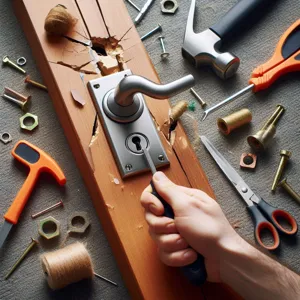
A broken door handle might seem like a minor inconvenience, but its impact can resonate throughout your home. Think about it: every time you encounter a door that won’t open smoothly, you’re faced with frustration, and that can disrupt the flow of your day. A functioning door handle is not just about convenience; it’s a fundamental aspect of security and privacy. A broken handle can leave your home vulnerable, compromise your peace of mind, and even lead to larger issues if left unaddressed.
Moreover, a faulty door handle can detract from the overall aesthetic of your space. Whether it’s a sleek modern design or a vintage charm, door handles play a significant role in your home’s decor. Fixing a broken handle not only restores functionality but also enhances the visual appeal of your doors, making them inviting and polished.
In this DIY guide, we’ll walk you through five easy steps to repair your broken door handle, empowering you to take control of your home maintenance. With just a few tools and a bit of time, you’ll find that fixing your door handle is not only achievable but also rewarding. Let’s dive into the details and get your doors back in working order!
2. Tools and Materials Needed for the Repair
Before diving into the repair process, it’s essential to gather all the necessary tools and materials to ensure a smooth and efficient fix. Here’s a handy list of what you’ll need:
**Tools:**
1. **Screwdriver**: Depending on your door handle, you’ll likely need either a Phillips or flathead screwdriver. A multi-bit screwdriver can be particularly useful, as it allows you to switch between different types of screws without needing multiple tools.
2. **Pliers**: A pair of pliers can help you grasp and manipulate small components, especially if they’re tightly fitted or difficult to reach.
3. **Utility Knife**: This can be useful for cutting away any old adhesive or seals, should your door handle be held in place by sticky materials.
4. **Drill**: If you need to replace screws or install a new handle, a drill will save you time and effort. Make sure to have the correct drill bits on hand.
**Materials:**
1. **Replacement Handle**: Ensure you have a handle that matches the style and size of your existing one. You can find suitable replacements at your local hardware store or online.
2. **Screws**: If your handle came without screws, or if the old screws are stripped or damaged, it’s wise to have a few extra screws of the correct size.
3. **Lubricant**: A silicone-based lubricant can help ensure smooth operation once your repair is complete, particularly if the handle mechanism feels stiff.
4. **Cleaning Supplies**: A cloth and some mild cleaner will help you tidy up the area around the door handle before and after the repair.
By gathering these tools and materials in advance, you’ll set yourself up for success, making the repair process as straightforward and hassle-free as possible. Once you have everything ready, you’ll be just a few steps away from restoring your door handle to its former glory!
3. Step 1: Identify the Type of Door Handle
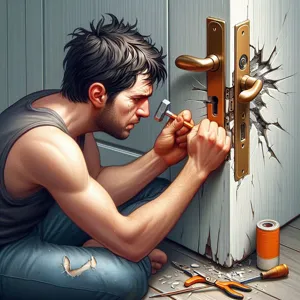
Before diving into repairs, the first crucial step is to identify the type of door handle you’re dealing with. Door handles come in various styles and mechanisms, each requiring a different approach for repair. Start by examining your door handle closely. Is it a traditional knob, a lever, or a more modern pull handle? Understanding the design can help you determine the tools and techniques you’ll need.
Next, pay attention to the mechanism itself. Is it a simple passage handle that allows free entry and exit, or does it have a locking mechanism that adds a layer of complexity? If it’s a lockable handle, you’ll want to check if the key is still functioning properly or if the lock cylinder is contributing to the problem.
Additionally, consider the material of the door handle. Is it made of metal, plastic, or perhaps wood? Different materials may require specific repair methods or replacement parts. For instance, a plastic handle may break more easily and could require a different approach than a robust metal one.
Once you’ve identified the type and mechanism of your door handle, you’re ready to move on to the next steps. Having a clear understanding of what you’re working with not only sets the stage for a smoother repair process but also saves you time and frustration down the line. So, take a moment to analyze your door handle—it’s a small but vital step in ensuring a successful fix!
4. Step 2: Remove the Broken Door Handle
Once you’ve gathered your tools and assessed the situation, it’s time to remove the broken door handle—a crucial step that sets the stage for a successful repair. Start by inspecting the handle itself; if it’s equipped with visible screws, grab your screwdriver and gently unscrew them. Be sure to keep these screws in a safe place, as you’ll need them later for reassembly.
If the handle is held in place by a decorative cover plate, you may need to pry it off carefully using a flathead screwdriver. Take your time with this step to avoid damaging the surrounding door surface. Once the cover is off, you’ll have clear access to the screws anchoring the handle.
In cases where the handle is stuck or the screws are stripped, a little finesse is required. Try wiggling the handle gently while turning the screws counterclockwise; this can sometimes help loosen stubborn components. If the handle is broken beyond repair, it might be necessary to apply a bit of force—just be cautious not to damage the door itself.
Once you’ve successfully unscrewed the handle, gently pull it away from the door. If you encounter resistance, double-check for any hidden screws or clips that may be holding it in place. With the broken handle removed, take a moment to clean the area around the door latch and inspect it for any damage that may need attention. Now you’re one step closer to restoring functionality to your door!
5. Step 3: Inspect the Mechanism for Damage
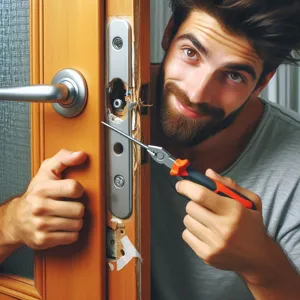
Once you’ve removed the door handle, it’s time to take a closer look at the internal mechanism. This step is crucial, as it allows you to identify any underlying issues that may be causing the malfunction. Start by inspecting the latch and the surrounding components for any signs of wear, rust, or misalignment. A damaged latch might be the reason your door handle isn’t functioning properly, so give it a thorough examination.
Next, check the screws and springs within the mechanism. Sometimes, a simple tightening of screws can resolve the issue, while other times, a spring might be broken or dislodged, requiring replacement. If you notice any components that are cracked or bent, it’s essential to replace them before reassembling the handle.
Additionally, take note of how the mechanism operates. If it feels stiff or doesn’t engage smoothly, it may need lubrication. A quick application of a silicone-based lubricant can often restore fluidity to the movement and enhance the overall performance of the door handle.
By carefully inspecting the mechanism and addressing any damage or wear, you set the foundation for a successful repair. This step ensures that when you reassemble the handle, it will function like new, allowing your door to open and close seamlessly once again. After completing this inspection, you’ll be ready to move on to the next step, where you’ll make any necessary repairs or replacements before putting everything back together.
6. Step 4: Replace or Repair the Broken Parts
In Step 4, you’ll tackle the heart of the repair process: replacing or repairing the broken parts of your door handle. This step is crucial since the functionality of your door handle hinges on the condition of its components. Start by examining the damaged parts closely. If the handle is cracked or the mechanism is jammed, you may need to replace the entire handle or just specific components, like screws, springs, or the latch.
If you’re opting for a replacement, head to your local hardware store with the old handle in hand. This will ensure you find a compatible replacement that matches both the style and size of your existing setup. Look for durable materials that can withstand daily use, such as stainless steel or brass, which not only offer longevity but also add a touch of elegance to your door.
However, if you prefer to repair, clean the broken parts thoroughly to remove any debris or rust that may be contributing to the malfunction. For minor cracks, a strong adhesive or epoxy can work wonders, providing a sturdy fix once it dries. For stripped screws or fittings, consider using a thread repair kit or larger screws that can hold the components firmly in place.
Once you have either replaced or repaired the parts, reassemble the handle carefully, ensuring everything is aligned correctly. As you reattach the screws, don’t overtighten them, as this may cause additional damage. Finally, give the handle a few test turns to ensure it operates smoothly. With these steps completed, you’ll be well on your way to restoring functionality to your door handle and enhancing the overall security of your space.
7. Step 5: Reinstall the Door Handle

After you’ve successfully replaced the broken components and ensured everything is in working order, it’s time for the final step: reinstalling the door handle. This is where your efforts truly come together, and you can take a moment to appreciate the progress made throughout the repair process.
Begin by aligning the handle with the door’s edge, ensuring that any screws or mounting holes line up correctly. Gently push the handle into place, taking care not to force anything, as this could damage both the handle and the door. If your door handle includes a spindle—a metal rod that connects the two handles—make sure it fits snugly through the hole in the door.
Next, grab your screws and a screwdriver, and secure the handle by tightening the screws—be careful not to over-tighten, as this can strip the holes or cause the handle to misalign. If your handle has a decorative cover or plate, now is the time to attach it, giving the handle a polished finish and concealing any visible screws.
Once everything is securely in place, test the handle by turning it several times to ensure it operates smoothly and without resistance. If you notice any sticking or unevenness, double-check that all screws are properly fastened and that the handle is aligned correctly.
Finally, take a step back and admire your handiwork! Reinstalling the door handle not only restores functionality but also enhances the overall aesthetic of your door. With just a few simple steps, you’ve successfully fixed a common household issue, saving time and money while boosting your confidence in DIY repairs. Now, go ahead and open that door with pride!
8. Tips for Ensuring a Secure Fit
When it comes to fixing a broken door handle, ensuring a secure fit is crucial for both functionality and safety. A wobbly or loose handle can lead to frustration and even compromise the security of your home. Here are some essential tips to guarantee that your newly installed handle is snug, secure, and ready for daily use.
**1. Choose the Right Size:** Before you begin, ensure that the replacement handle you’ve selected is the correct size for your door. Measure the diameter of the existing holes and the thickness of the door to avoid any surprises during installation. A properly sized handle not only fits better but also enhances the overall aesthetic of your door.
**2. Use Quality Hardware:** Investing in high-quality screws and fittings is vital. Cheap or worn-out screws can strip easily and lead to a loose handle over time. Opt for stainless steel or brass screws, which provide durability and resist corrosion, ensuring that your handle stays firmly in place even in varying weather conditions.
**3. Align Components Properly:** As you assemble the handle, take extra care to align the internal components accurately. Misalignment can lead to unnecessary strain on the handle, resulting in premature wear or breakage. Use a level or a guide to ensure everything is straight and properly aligned before tightening any screws.
**4. Tighten Securely but Not Overly:** As you fasten the screws, aim for a firm but gentle grip. Over-tightening can strip the screw holes or damage the door material, compromising the integrity of the installation. A well-secured handle should feel solid without excessive force.
**5. Test the Handle:** Once your handle is installed, give it a few test turns and pushes. Check for any wobbling or looseness. If you notice any movement, double-check your installation steps. It may be necessary to adjust the screws or realign the components to achieve that perfect, secure fit.
By following these tips, you can ensure that your door handle not only looks great but functions flawlessly, providing you with peace of mind and years of reliable use. With a little attention to detail, you’ll have a secure fit that allows you to open and close your door with confidence.
9. Common Mistakes to Avoid During the Repair
When tackling the task of fixing a broken door handle, it’s easy to overlook some crucial details that can lead to frustration or even further damage. Here are some common mistakes to avoid during your repair process, ensuring a smoother and more effective experience.
**1. Skipping the Diagnostic Step:**
Before you grab your tools, take a moment to thoroughly assess the door handle and the surrounding mechanism. Failing to identify the specific issue—whether it’s a loose screw, a broken latch, or a misaligned plate—can lead to unnecessary repairs or the wrong replacement parts being purchased.
**2. Using Incorrect Tools:**
Using the right tools is essential for a successful repair. Many DIYers might try to make do with whatever is on hand, but this can lead to stripped screws or damaged components. Ensure you have the correct screwdriver, pliers, and any other necessary tools specific to your door handle type.
**3. Over-tightening Screws:**
While it might seem logical to tighten the screws as much as possible to secure the handle, over-tightening can actually cause damage to the handle or the door itself. Instead, find a comfortable snugness—just enough to hold the handle securely without straining the material.
**4. Neglecting Lubrication:**
After you’ve successfully reattached your door handle, it’s easy to overlook lubrication. A bit of grease or a silicone spray can go a long way in ensuring the handle operates smoothly and prolongs its lifespan. Skipping this step can lead to future sticking or squeaking.
**5. Ignoring Aesthetic Details:**
A repair isn’t just functional; it should also look good. After completing the fix, take a moment to clean up any smudges or dirt around the handle and door area. This attention to detail not only improves the appearance but can also add a finishing touch that makes your DIY effort stand out.
By being mindful of these common pitfalls during your door handle repair, you can streamline the process and achieve a professional-looking fix with ease.
10. Maintenance Tips for Preventing Future Breakages
Maintaining your door handles is essential for ensuring their longevity and functionality. Just like any other part of your home, door handles require attention and care to prevent future breakages. Here are some simple yet effective maintenance tips to keep your door handles in top condition.
**1. Regular Cleaning:** Dust and debris can accumulate around door handles, leading to wear and tear over time. Use a soft, damp cloth to wipe down the handles regularly. For metal handles, consider using a mild detergent to remove any grime, followed by a quick dry with a clean cloth to prevent rust.
**2. Lubrication is Key:** To ensure smooth operation, apply a few drops of lubricant to the handle’s moving parts, particularly if you notice any squeaking or stiffness. A silicone-based lubricant is ideal as it doesn’t attract dust and dirt like oil-based options.
**3. Check for Loose Screws:** Periodically inspect the screws and bolts that secure the door handle. Vibrations from daily use can loosen these attachments, leading to instability. Tighten any loose screws with a screwdriver to maintain a secure fit.
**4. Avoid Excessive Force:** Educate family members and guests about using door handles gently. Yanking or applying excessive force can lead to breakages, especially in older or more delicate handles. A gentle push or pull is all that’s needed for proper operation.
**5. Replace Worn Parts Promptly:** If you notice any signs of wear, such as cracks or chips in the handle, address them immediately. Replacing worn parts before they fail completely can save you time and money in the long run.
By incorporating these maintenance tips into your routine, you can significantly extend the life of your door handles, ensuring they continue to function smoothly and efficiently for years to come. A little proactive care goes a long way in preventing those frustrating breakages from occurring again!
11. When to Call a Professional
While many door handle repairs can be tackled with a bit of DIY enthusiasm and basic tools, there are certain situations when calling in a professional is the best course of action. If your door handle is part of a complex locking system, for instance, or if it’s integrated into a high-security door, it might be wise to seek expert help. Professionals possess the technical know-how to handle intricate mechanisms that can be easily damaged by inexperienced hands.
Additionally, if you encounter persistent issues such as a door that won’t latch, a handle that feels loose despite your best efforts, or if the entire door frame seems out of alignment, these could be signs of underlying structural problems that require a skilled eye to assess.
Another indicator is if you find yourself without the proper tools or materials to complete the job safely and effectively. Sometimes, the right tools make all the difference in achieving a repair that is not only functional but also aesthetically pleasing.
Lastly, if you simply don’t feel confident tackling the repair or if the thought of disassembling a door handle sends shivers down your spine, there’s no shame in reaching out for professional assistance. Remember, a door handle is a crucial component of your home’s security, and ensuring it’s fixed correctly is paramount for your peace of mind. By knowing when to call a professional, you can avoid further complications and ensure your door handle is repaired safely and efficiently.
12. Conclusion: Enjoy Your Repaired Door Handle!
Congratulations! You’ve successfully navigated the journey of repairing your broken door handle, and now it’s time to revel in the satisfaction of a job well done. As you stand back and admire your handiwork, take a moment to appreciate the small but significant transformation you’ve achieved in your space. A functioning door handle not only enhances the aesthetics of your door but also restores a sense of security and ease of access to your home.
With just a few tools and a little bit of patience, you’ve learned how to diagnose the issue, gather the right materials, and execute a straightforward repair. Whether you opted for a simple tightening, a complete replacement, or a creative workaround, you’ve empowered yourself with the skill to tackle similar issues in the future. This newfound confidence in your DIY abilities extends beyond just door handles; it opens the door (pun intended!) to tackling other small home repairs and projects.
Now, every time you open or close that door, you can take pride in knowing you handled the situation yourself. So go ahead, give your repaired door handle a test run, and enjoy the smooth operation. And remember, the next time something breaks or needs fixing around your home, don’t hesitate to roll up your sleeves and dive in—after all, there’s nothing quite like the feeling of turning a problem into a solution with your own two hands!
In conclusion, fixing a broken door handle doesn’t have to be a daunting task. With just a few simple tools and our easy-to-follow five-step guide, you can restore functionality to your door in no time. Not only will you save money by tackling this DIY project yourself, but you’ll also gain the satisfaction of knowing you’ve enhanced the safety and accessibility of your home. Whether it’s a pesky knob that won’t turn or a handle that’s come loose, we hope this guide empowers you to take control of your home repairs. So gather your tools, roll up your sleeves, and let your newfound skills shine—your doors will thank you! If you found this guide helpful, be sure to share your success stories or any questions you may have in the comments below!



